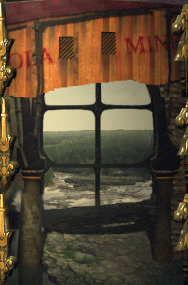
GRANOLA MINES
 |
MORE IMAGES: Granola Miners (c. 1167~1247) (A) / (higher-res) REPORTED FAUNA/BEASTS/FOES: Bat, Giant (GMU) Boot, Giant (GMU) Dust Bunny (GMU) Frobgoblin (GMU) Ghoul (GMU) Kobold (GMU) Nymph (GMU) Ogre (GMU) Rat-ant (GMU) Skeleton (GMU) Spider, Giant (GMU) Surmin (GMU) Troll (GMU) |
The conquest of Antharia in 665 GUE gave Pseudo-Duncanthrax possession of Antharia’s granola mines. Unfortunately, no one in Quendor liked granola. As Pseudo-Duncanthrax’s invasion swept across the Eastlands, he made a startling discovery: huge caverns and tunnels, populated by gnomes, trolls and other magical races, all of whom loved granola. Not only would he extend his empire, but he would finally have a market for all the useless accumulated granola.
With the absorption of the immense granola smelters of Antharia and the granola-hungry semi-barbarized population of the east, granola production and consumption rose to dramatic importance within the Quendoran economy within a mere ten years. Over the course of the next century or so, an elaborate legal and economic framework sprang up around the ensuing granola trade: tax revenue from the western provinces served to support the mining, packing and shipping of granola from the center of the ocean to the distant provinces in the East. Despite the enormous granola consumption of the Eastlands, the Antharian mines never managed to achieve self-sufficiency. Combined with the Curse of Megaboz in 789, this eventually led to the Granola Riots of 16 Estuary 865 GUE.
Since then the output of the mines fell sharply and its vast transportation system lay in ruins. Despite the reduced output, they still are an interesting tourist attraction and advertized as "Clusters of FUN for the Whole Family", if one can stand the smell.
At the start of the Second Age of Magic, the Fourth Dungeon Master had his hands full quelling a Granola Rebellion. While no further details of this event are extant in any available document, it may be this event that made it easy for the Granola Mines to be overrun by monsters during the start of the Great Monster Uprising. Regardless, at that time, due to the monster infestation, all granola mining operations came to an eventual halt, with an exception of some independent miners (such as an unknown surfer) who continued to work the land, routing the dry foodstuff to various parts of the world.
OTHER NOTES:
It was to these mines, where the royal families of the platypus kingdoms sent their prisoners to fulfill their many year sentences of backbreaking labor. The earliest report of this activity is in 966, and the latest 1157.
During his middle years, Ralph Waldo Flathead spent nearly half a decade living in the granola mines of Antharia. It was during this period that he wrote his longest work, a 60,000-verse epic about the varieties of moss that one finds in granola mines.
During the years of the Great Monster Uprising, a magically animated statue of a wizened old man made out of granola inhabited the mine. Without asking the sentinent statue if he wanted to be made, or consulting him, or considering his feelings on the matter, a wizard not only gave the inanimate object animation, but also the ability to speak (despite that he did not have any vocal cords).
| SOURCE(S): Zork I (History of the Great Underground Empire), Zork II (The GUE on 9 Zorkmids a Day), Wishbringer, Zork Zero, History of Quendor, Legends of Zork, The Magic Trilogy (official press release) |